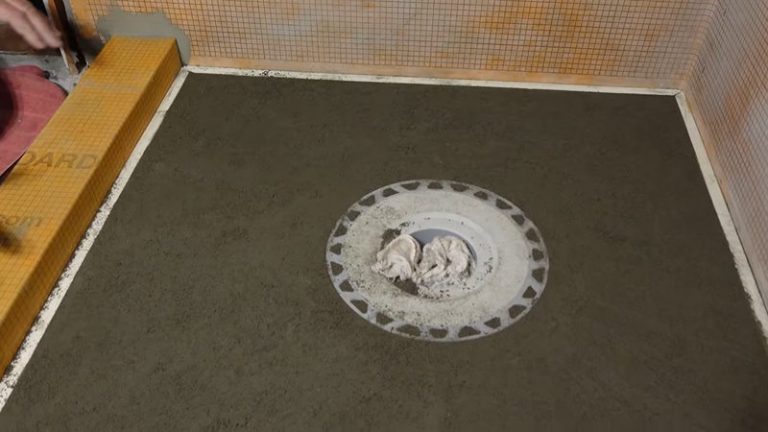Kerdi Board Thickness: The #1 Mistake You Can’t Afford to Make
You’re standing in the aisle, ready to start your dream bathroom project. You’ve decided on Schluter-Kerdi-Board for its legendary waterproofing capabilities, but a wall of orange foam panels confronts you, each with a different thickness. Suddenly, a wave of uncertainty hits: does it really matter which one I choose? The answer is a resounding yes.
Choosing the wrong Kerdi-Board thickness is more than a simple mistake; it’s a decision that can compromise the structural integrity of your entire tile installation, leading to cracks, leaks, and a catastrophic failure that costs thousands to repair. This guide will demystify the options, ensuring you select the perfect panel for a waterproof, stable, and long-lasting project.
You'll Learn About
What Is Kerdi-Board and Why Is Thickness Crucial?
Schluter-Kerdi-Board is a multifunctional, waterproof building panel made from an extruded polystyrene foam core. It features a special reinforcement material and fleece webbing on both sides, designed to create a perfect bond with thin-set mortar. Unlike traditional drywall or cement backer board, Kerdi-Board is inherently waterproof and acts as a vapor retarder, making it an all-in-one substrate for tile.
The thickness of the board you choose directly impacts its rigidity, its load-bearing capacity, and its suitability for a specific application. A board that’s too thin for the job can flex, leading to cracked tiles and grout. Conversely, a board that’s too thick can create awkward transitions and unnecessary expense. Understanding the intended use for each thickness is the key to success.
A Complete Breakdown of Kerdi-Board Thicknesses and Their Uses
Kerdi-Board is available in eight standard thicknesses, ranging from thin panels for covering existing walls to thick, structural boards for building custom shower elements. Each has a specific purpose, and matching the thickness to the application is non-negotiable for a professional-quality result.

Thin Panels (3/16″ & 1/4″): Perfecting the Surface
The thinnest Kerdi-Board options are not designed for structural use. Instead, they are master problem-solvers for creating a flat, waterproof surface over existing substrates. If you have a solid, flat wall of moisture-resistant drywall or even existing tile that is well-bonded, these panels are your go-to.
Use the 3/16″ (5 mm) or 1/4″ (9 mm) boards to quickly waterproof a tub surround or create a smooth substrate for a backsplash. They are ideal for ensuring a perfectly even surface before tiling, correcting minor imperfections without adding significant bulk to the wall assembly. These panels must be fully embedded in thin-set mortar over a continuous, stable substrate.
The Workhorse Panels (3/8″, 1/2″ & 5/8″): For Walls and More
This mid-range of thicknesses is the most versatile and commonly used. These boards are suitable for going directly over stud framing, making them a direct replacement for traditional backer boards in wet areas.
The 1/2″ (12.5 mm) board is the industry standard for shower walls where studs are spaced 16 inches on center. Its rigidity is sufficient to provide a solid, unyielding backing for tile, preventing flex that can lead to failure. The 5/8″ (15 mm) board offers slightly more rigidity and is often used to match the thickness of adjacent drywall for a seamless transition outside the wet area.
The 3/8″ (9 mm) thickness can be used when spot-bonding to an existing solid wall, providing a flat and waterproof surface. This method is excellent for masonry or uneven plaster walls where building out a new frame isn’t practical. It allows you to create a plumb and true surface for tiling with minimal effort.
Thick and Structural Panels (3/4″ to 2″): Building Custom Elements
When your project moves beyond flat walls into the realm of custom construction, the thicker Kerdi-Board panels are essential. These boards are designed to be self-supporting and load-bearing, allowing you to build shower elements that once required complex framing and waterproofing.
Use the 3/4″ (19 mm), 1″ (25 mm), 1-1/2″ (38 mm), and 2″ (50 mm) panels for applications like:
- Shower Benches and Seats: Create sturdy, waterproof benches without any wood framing.
- Partition Walls: Build half-walls or entire shower enclosures that are tile-ready from the start.
- Vanities and Countertops: The thickest boards are stable enough to construct floating vanities or countertops.
- Shower Niches and Shelving: Build custom, fully waterproofed storage directly into your shower walls.
- Shower Curbs: While Schluter makes prefabricated curbs, you can easily construct a custom shower curb thickness using 2″ board.
The 2″ (50 mm) board is generally recommended for self-supporting partition walls. When building benches or shelves, the required thickness will depend on the span and expected load, but 3/4″ is a typical minimum for shelving. Knowing how much weight a Kerdi curb can hold is a testament to the structural power of these thicker panels.
Choosing the Right Kerdi-Board Thickness: A Quick Guide
Navigating the options can be simplified with a clear chart. Use this table as a quick reference for your next project to ensure you’re making the right choice based on your specific application.
| Thickness (Inches) | Thickness (mm) | Primary Application | Installation Method |
|---|---|---|---|
| 3/16″ | 5 | Waterproofing over existing flat substrates (drywall, cement board) | Fully embedded in thin-set |
| 1/4″ | 9 | Waterproofing over existing flat substrates, correcting minor imperfections | Fully embedded in thin-set |
| 3/8″ | 9.5 | Spot-bonding over uneven but solid substrates (e.g., masonry) | Spot-bonded with thin-set |
| 1/2″ | 12.5 | Standard for walls over studs (16″ o.c.) | Screws & washers directly to studs |
| 5/8″ | 15 | Walls over studs (16″ o.c.), matching thicker drywall | Screws & washers directly to studs |
| 3/4″ | 19 | Walls over studs (24″ o.c.), shelving, benches | Screws & washers / structural bonding |
| 1″ | 25 | Benches, partitions, structural elements | Structural bonding with thin-set or KERDI-FIX |
| 1-1/2″ | 38 | Vanities, countertops, robust benches | Structural bonding with thin-set or KERDI-FIX |
| 2″ | 50 | Self-supporting partition walls, curbs, large benches | Structural bonding with thin-set or KERDI-FIX |
Critical Installation Factors Tied to Thickness
Selecting the correct thickness is only half the battle. Your installation method is directly dictated by the board’s thickness and the underlying structure. Getting this wrong can negate the benefits of using a premium product.
Stud Spacing: The Golden Rule for Walls
The most critical factor when installing Kerdi-Board directly on a frame is the spacing of your studs. This relationship determines the minimum board thickness required to create a rigid, stable wall.
- For studs spaced 16 inches on center, you must use a minimum board thickness of 1/2″ (12.5 mm).
- For studs spaced 24 inches on center, the minimum thickness increases to 3/4″ (19 mm).
Attempting to use a thinner board on wider stud spacing will result in a flexible wall. This movement will inevitably transfer through to your tile, causing grout to crack and tiles to loosen over time.
Fastening Matters: Screws and Washers
When attaching Kerdi-Board to framing, you must use Schluter’s proprietary screws and washers. The washers are specifically designed to distribute the load and prevent the screw head from pulling through the foam panel. The maximum allowable on-center fastener spacing is 12 inches for walls and 6 inches for ceilings.
The screw length is also crucial. For wood studs, screws must penetrate at least 3/4″. For metal studs, a 3/8″ penetration is required. Using the wrong fastener can lead to a board that is not securely attached to the wall, creating a disastrously unstable substrate.
Waterproofing the Seams
Regardless of the thickness you choose, the waterproofing integrity of a Kerdi-Board assembly relies on treating the seams. All joints between boards, corners, and fastener penetrations must be sealed with Kerdi-Band waterproofing strips, embedded in unmodified thin-set mortar. While Kerdi-Board is a fantastic product, it’s part of a larger system. When comparing options like Red Guard waterproofing vs Kerdi, it’s important to remember that the Kerdi system’s reliability comes from using all its components correctly.
Avoiding Common Thickness-Related Mistakes
Many well-intentioned DIY projects go wrong because of a few common, easily avoidable errors related to board thickness.
Mistake #1: Using Thin Board Over Studs
The most frequent and costly mistake is using 1/4″ or 3/8″ board directly on studs to save money. These boards lack the structural rigidity for this application and will flex significantly, leading to guaranteed tile failure. Always adhere to the minimum 1/2″ thickness for 16″ on-center studs.
Mistake #2: Ignoring Transitions to Drywall
When your shower wall meets the rest of the bathroom, the thickness of your Kerdi-Board needs to align with the drywall. Using 1/2″ Kerdi-Board next to 1/2″ drywall creates a smooth, flat transition. If you use a different thickness, you will have to build up the wall with mortar to float it out, adding significant time and complexity to the job.
Mistake #3: Underestimating Loads on Benches and Shelves
When building a shower bench, don’t skimp on thickness. A 3/4″ or 1″ board might seem sufficient, but a 1-1/2″ or 2″ board provides far superior rigidity and load-bearing capacity, ensuring the structure is safe and durable. Always consider the span of the bench or shelf and err on the side of a thicker, more robust panel.
Ultimately, selecting the correct Kerdi-Board thickness isn’t just a technical detail—it’s the foundational decision that ensures your tiled masterpiece will stand the test of time. By understanding the specific role of each panel thickness and adhering to the proper installation guidelines, you can build with confidence, knowing your project is not just beautiful, but built to last.

